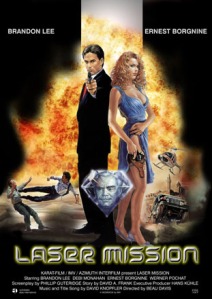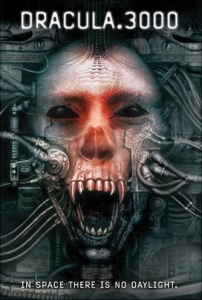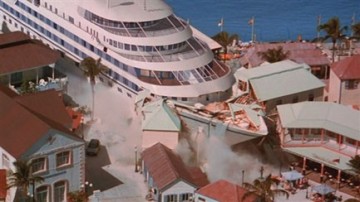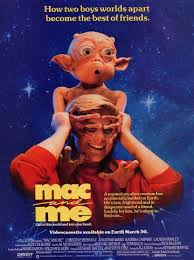The Stepford Wives
Today’s film is a truly unnecessary and awful remake: Frank Oz’s “The Stepford Wives,” from 2004.
The screenplay for “The Stepford Wives” was written by Paul Rudnick, who also penned “Jeffrey” and “Addams Family Values.” The story is very loosely based on a novel by Ira Levin, who also wrote “Rosemary’s Baby” and “A Kiss Before Dying.” The novel was originally adapted for the screen in 1975 by Bryan Forbes, and that flick is a well-regarded classic science fiction thriller.
The director for “The Stepford Wives” was Frank Oz, who has directed such films as “The Dark Crystal” and “Little Shop of Horrors.” However, he is best known as a celebrated voice actor, and is behind such iconic characters as Yoda, Miss Piggy, Fozzie Bear, and The Cookie Monster.
The cinematographer on “The Stepford Wives” was Rob Hahn, who previously shot for Frank Oz on “In & Out” and “The Score.” Most of his career has been spent as a camera operator on films like “Midnight Run,” “Batman Returns,” and “The Golden Child.”
The score for “The Stepford Wives” was done by David Arnold, who also did the music for such films as “Hot Fuzz,” “Casino Royale,” and “Stargate.”
The editor for “The Stepford Wives” was Jay Rabinowitz, an accomplished worker who has cut movies such as “Rosewater,” “The Fountain,” “Requiem For A Dream,” “Dead Man,” and “Mother Night.”
The producers for “The Stepford Wives” included Ronald M. Bozman (“Philadelphia,” “The Silence of The Lambs,” “The Ref”), Donald De Line (“Yogi Bear,” “Burlesque”), Leslie J. Converse, who was previously Frank Oz’s assistant, Scott Rudin (“Ex Machina,” “The Social Network”), and Edgar Sherick, one of the producers from the original movie who sadly died before the remake was released.
The cast for “The Stepford Wives” is headlined by Nicole Kidman (“Eyes Wide Shut,” “Australia”), Bette Midler (“Hocus Pocus”), Matthew Broderick (“Godzilla,” “Addicted to Love”), Christopher Walken (“The Dead Zone,” “True Romance”), Glenn Close (“Fatal Attraction,” “Damages”), Roger Bart (“The Midnight Meat Train,” “The Producers”), and Jon Lovitz (“Saturday Night Live,” “Happiness”).
 The story of “The Stepford Wives” centers around a high powered television executive who is suddenly fired from her company. Her family decides to move with her to the small, suburban, Connecticut town of Stepford, where she can recover from the stress of losing her job. However, there is a dark secret to the town of Stepford and the surreal families that inhabit it.
The story of “The Stepford Wives” centers around a high powered television executive who is suddenly fired from her company. Her family decides to move with her to the small, suburban, Connecticut town of Stepford, where she can recover from the stress of losing her job. However, there is a dark secret to the town of Stepford and the surreal families that inhabit it.
Oddly, this remake of “The Stepford Wives” isn’t really even in the same genre of the original film/novel, which emphasize the elements of science-fiction, thriller, and mystery. This film, in contrast, is a black comedy with loose elements of science-fiction interspersed, with little to no thrilling aspects.
During an interview with the AV Club, Frank Oz spoke at length about his feelings on “The Stepford Wives”:
The Stepford Wives was too big and it was unsatisfying to do. Not that it was unsatisfying to do, but it was unsatisfying as a result, because as much as I loved parts of it, and I’m really proud of so much of it, the entire movie wasn’t what I wanted it to be. It’s my own fault, I didn’t follow my instincts
….
on Stepford Wives, for the first time and through nobody’s fault but my own, all the actors were great, but I was too beholden to the budget —I felt too responsible if the budget was getting higher. And I don’t like to work with that high a budget, and I tried to play it safe in decision-making, as opposed to following my gut, subversive instincts. And it was a mistake, my mistake totally.
…
[The direction/tone] wasn’t clear. That’s ’cause the director didn’t have a clear thought. Totally my fault.
The reception to “The Stepford Wives” was certainly not positive. The film currently has a rating of 5.2 on IMDb, with Rotten Tomatoes scores of 26% (critics) and 29% (audience).
Nancy Griffin of The New York Times wrote an article about the issues surrounding the production of “The Stepford Wives” just days before the theatrical release. Apparently there were numerous test screenings, last minute edits, re-shoots, and immense tensions between various cast and crew members, which made for a hostile set and generally disjointed production.
“The Stepford Wives” was made on a budget of $90 million, and ultimately grossed a total of roughly $102 million in it’s theatrical run. That made the movie profitable, but due to not meeting expectations and being hated by critics, it is publicly remembered as a failure.
One of the biggest problems with “The Stepford Wives” is that all of the characters are utterly despicable, to the point that they aren’t even believable. There is also no real comeuppance for the majority of them. For instance, the villainous husbands are ultimately punished by being forced to do the household shopping at the grocery store. Personally, I try to believe that most functioning, healthy adults can handle going to a grocery store. Speaking of which, why are all of these husbands portrayed as oafs? When it comes down to it, they are evil. They essentially sacrifice the lives of their spouses so they can be lazy, but I’ll delve more into their sinister behavior later. Even Nicole Kidman’s lead character is introduced as being a hateful, exploitative piece of human garbage, and she never really does anything to redeem herself. In fact, one line of dialogue (from her husband) describes her in the following way:
“Your whole attitude makes people try to kill you.”
After she learns to cook and dress in colors, the audience is just supposed to forgive her for being such an ass previously, which makes for quite the borked moral compass on the whole.
Speaking of which, the characters make for the biggest difference between this 2004 remake and the original film. Matthew Broderick’s character is much deeper, sinister, and subtle figure in the original movie, which is replaced by an awkward but well-meaning buffoon in the remake. Likewise, the protagonist in the original film is a relateable, artistic feminist in a community clinging to outdated, conservative values. In the remake, Kidman is a strawman version of a business world feminist, and lacks any of the soul or depth that made the original character interesting. The cinematography, lighting, and tension are also big departures from the original film, and the only real improvements in the remake are (arguably) the musical score and production design. For instance, the famous grocery store scene looks much better in the remake, but doesn’t have nearly the same gravity as it does in the original, and further doesn’t fit in with the comedic style of the remake at all.
To the credit of “The Stepford Wives,” it does have brief flashes of humor. Jon Lovitz always has a way of lighting up in minor roles, and Bette Midler’s seething deliveries in the film are unparalleled. That said, Broderick and Kidman both wind up being pretty wooden, which is a big problem given the importance of their roles. Glenn Close does a good job of making her role hammy and larger-than-life, but the rest of the wives are perhaps a little too good at being robots. Christopher Walken is also unfortunately a bit disappointing, especially given what we all know he is capable of doing.
“The Stepford Wives” is a waste of a pretty good cast and an excellent story, which is twisted into something that is simultaneously a vapid sex comedy and a cynical quasi-dissection of relationships. The film is misanthropic and bitter with a thin veneer of comedy, and it never really seems to lighten up. The whole tone is biting enough that the movie seems to despise it’s own existence, particularly as it lazily tries to stab at societal gender roles while simultaneously reinforcing them. It is a confused, self-loathing piece of work.
One of the biggest questions I have about “The Stepford Wives” remake is this: how exactly do the wives work? Are they replaced with robots, as they were in the original movie and novel? That doesn’t appear to be the case, because they are fixed/cured in the end. Are they victims of some kind of mind control? That is how the plot haphazardly tries to explain it, but that doesn’t cover the electrical shocks and glitches seen earlier in the film. Are they cyborgs, equipped with artificial enhancements? They don’t appear to affected at all after they are freed, even the ones that previously functioned as ATMs. However, that is the only explanation that really makes sense, and it directly contradicts what is said in the exposition. The story tries to claim that the wives are solely the result of implanted microchips, but that fails to explain the remote controls, the aforementioned sparks, the mechanical motion bugs, or the inexplicable inflatable boobs. I’m curious if there were major changes to the screenplay that might explain some of these vestigial details, or if this treatment just never made any sense from the start.
The biggest change for this remake was the axing of the original, downer ending. I’m guessing going full “Pod People” made the husbands too nefarious for the comedic-focused remake. But, as far as I am concerned, they were already re-written as unapologetic rapists for the re-imagining of the story. When it comes down to it, you can’t give consent when you have a mind control chip in your head, and being married isn’t an on-demand sex entitlement agreement. So, how exactly are these mind-controlling rapists more likable and appropriate for a comedy than the murderous, conspiratorial husbands from the original? Personally, I don’t think they are, and the fact that they are portrayed as just being oafs as opposed to villains makes the internal morality of the film even more twisted.
Another one of my problems with the writing of “The Stepford Wives” is the way that the comedy is structured. It is all set up and delivered in such a way that you can almost hear a laugh track after every lazily placed joke. It makes all of the conversations feel more inorganic than the actual robots in the story, and doesn’t do anything to make the characters feel like anything other than sloppy cut-outs.
As far as the effects in “The Stepford Wives” go, the worst thing I saw was the robot dog, which apart from being excessively goofy, looks absolutely awful. Would it have been so difficult to make a physical robot dog, like K-9 from “Doctor Who”? Because, as you should expect, the computer generated mutt has aged incredibly poorly. Or, better yet, maybe a robot dog wasn’t a necessary addition for the film?
I’m been wracking by brain trying to figure out why Frank Oz decided to do “The Stepford Wives.” My best guess is that he believed that it had the potential to catch the same lightning of “Little Shop of Horrors,” which was also a remake of a classic film in a new genre. It is still remembered as his career highlight as a director, and I suspect that it sat in the back of his mind throughout the production. However, “The Stepford Wives” doesn’t play to his specialties in the way that “Little Shop of Horrors” did: namely, the puppet effects. Also, “Little Shop of Horrors” was already tightly written for the stage, which “The Stepford Wives” certainly was not. If “Stepford” had been rewritten before going into production, some of the major problems might have been ironed out. Unfortunately, as it is, the movie is a castle built on sand.
“The Stepford Wives” is twisted in all the wrong ways. It fails to be an insightful satire, an interesting sci-fi, or a funny comedy. It is a complete failure in all of its intentions, and the amount of star-power behind it just made it fall all the harder. The fact that it is branded as a remake is an insult to the source material, and I’m honestly a little confused what it was not just called something else and played as a parody.
Despite a few funny lines, “The Stepford Wives” isn’t really worth the time to sit through. It isn’t enjoyable, though it isn’t brutally unwatchable either. However, there is so much wrong with the writing, characters, logic, and internal morality that the film approaches being a spectacle of wrongness, and an exemplar of just how awful a Hollywood product can be. All of that said, the original “The Stepford Wives” is a fine movie, and I’ll give the remake credit for bringing a new audience to it.
![Misan[trope]y](https://misantropey.files.wordpress.com/2014/10/misantropeyhead1.png)




















































